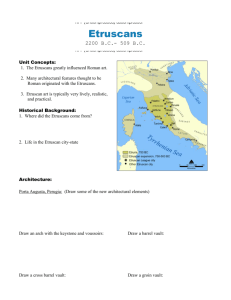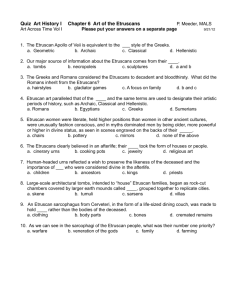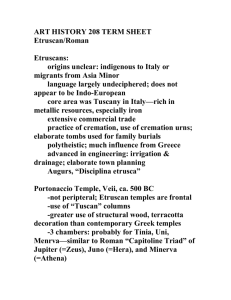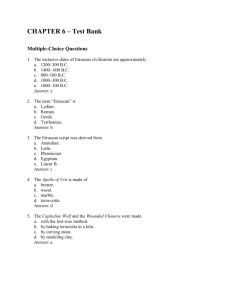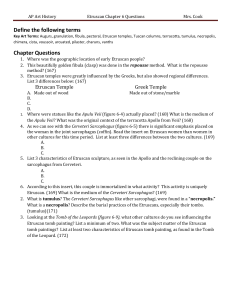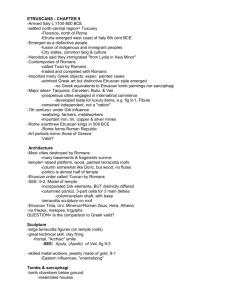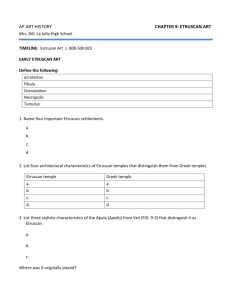M39_The Etruscan World_C38.indd
advertisement
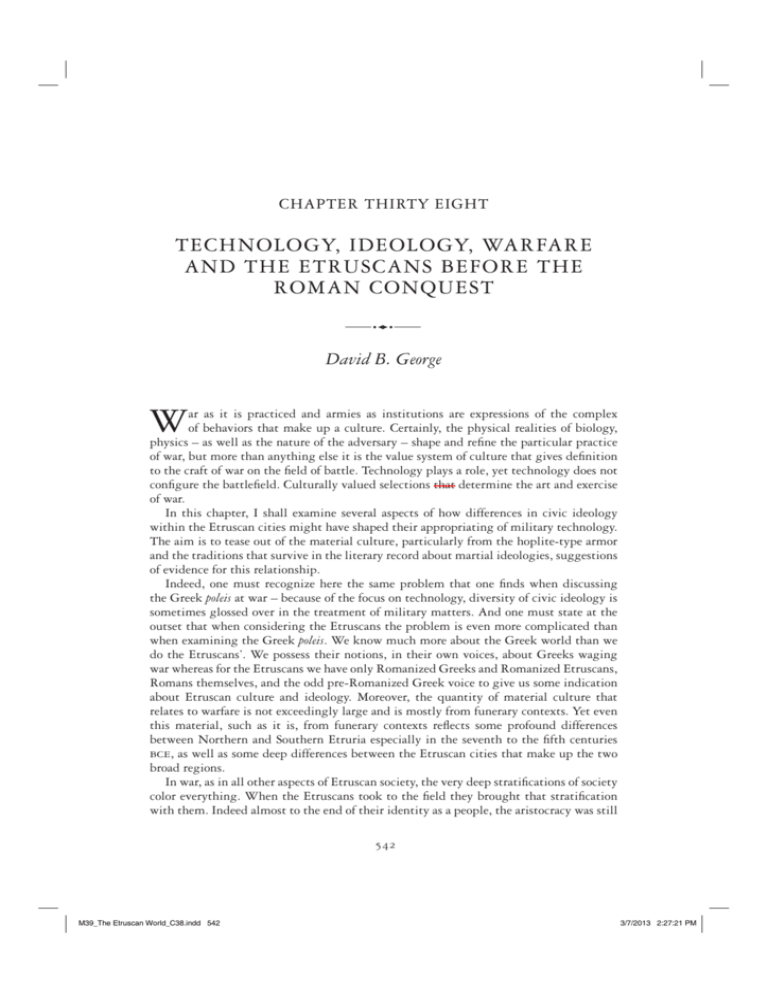
CHAPTER THIRTY EIGHT TECHNOLOGY, IDEOLOGY, WARFARE AND THE ETRUSCANS BEFORE THE ROMAN CONQUEST David B. George W ar as it is practiced and armies as institutions are expressions of the complex of behaviors that make up a culture. Certainly, the physical realities of biology, physics – as well as the nature of the adversary – shape and refine the particular practice of war, but more than anything else it is the value system of culture that gives definition to the craft of war on the field of battle. Technology plays a role, yet technology does not configure the battlefield. Culturally valued selections that determine the art and exercise of war. In this chapter, I shall examine several aspects of how differences in civic ideology within the Etruscan cities might have shaped their appropriating of military technology. The aim is to tease out of the material culture, particularly from the hoplite-type armor and the traditions that survive in the literary record about martial ideologies, suggestions of evidence for this relationship. Indeed, one must recognize here the same problem that one finds when discussing the Greek poleis at war – because of the focus on technology, diversity of civic ideology is sometimes glossed over in the treatment of military matters. And one must state at the outset that when considering the Etruscans the problem is even more complicated than when examining the Greek poleis. We know much more about the Greek world than we do the Etruscans’. We possess their notions, in their own voices, about Greeks waging war whereas for the Etruscans we have only Romanized Greeks and Romanized Etruscans, Romans themselves, and the odd pre-Romanized Greek voice to give us some indication about Etruscan culture and ideology. Moreover, the quantity of material culture that relates to warfare is not exceedingly large and is mostly from funerary contexts. Yet even this material, such as it is, from funerary contexts reflects some profound differences between Northern and Southern Etruria especially in the seventh to the fifth centuries bce, as well as some deep differences between the Etruscan cities that make up the two broad regions. In war, as in all other aspects of Etruscan society, the very deep stratifications of society color everything. When the Etruscans took to the field they brought that stratification with them. Indeed almost to the end of their identity as a people, the aristocracy was still 542 M39_The Etruscan World_C38.indd 542 3/7/2013 2:27:21 PM – c h a p t e r 3 8 : Te c h n o l o g y , i d e o l o g y a n d w a r f a r e – characterizing its right to lead based upon martial skill and leadership in most of the cities. In many cities the ability, on one’s own authority and from one’s own resources, to field and presumably arm troops was a mark of aristocratic greatness. Consider for example Dionysius’ (9.5.4) account of a battle near Veii around 480 bce. As the Roman consuls advance on Veii, Dionysius describes them as unnerved by what they see. Spread out in front of the city, in good order, is arrayed the might of the enemy ( ). It was considerable in both number and quality. But here Dionysius gives an important piece of information. The city army of Veii has been augmented by the chief men of rank, ( – hoi dynatotatoi) from other cities throughout Etruria ( ) with their own clients and dependents ( ). The word (penestes) likely refers to that class of people who were not quite in servile status but not quite free and tied to a specific (dynatotatos), clan or family with obligations to work the land as well as supply military service.1 (On social classes, see Chapter 21.) It is likely that the (dynatotatos) was under some sort of a personal or familial obligation to whoever was requesting help for the city. There was no citywide political structure to approve, deter, or compel aristocratic participation in a particular conflict. Also, it is quite likely that the (dynatotatos) himself was responsible for equipping his dependents. His personal glory and honor would be reflected in both the number of troops and how finely they were equipped. This is likely the origin of the 125 Negau type helmets that were found in 1905 at Vetulonia deposited near the walls of the arx and inscribed with the gentilicial name haspnas.2 These helmets would have been owned by the haspnas gens (clan) and distributed to the penestes and perhaps other dependent classes when needed. This rather archaic social structure for levying troops would have been reflected on the battlefield in a number of ways. As noted, in this case, the consuls were taken aback by both the size of the army ( ) and the quality of its weapons ( ).3 This implies that there was no means for anticipating, by friend or foe alike, the number or quality of troops who would turn out for any particular battle. The other implication of this is that the various elements of the army are not likely to have trained together or been armed in the same way. It would have been composed of two distinct groups, the aristocratic class and the (penestes), each with very narrowly defined functions. The (penestai), if fully armed, would have been equipped with a round Etruscan style helmet, a sword or ax and perhaps a shield. But it is likely that at times they would have had, other than a helmet, only an offensive weapon.4 Their weapons would not have required much training and would not have been very different from agricultural implements. Indeed the use of a scythe on a farm would be good practice for use of the curved sword (kopis). These weapons would have necessitated fighting in loose formations and so battle would tend to be individual against individual. For the aristocratic warrior ideology, we have a good deal of evidence from material culture. One interesting piece is a bucchero pesante oinochoe from Ischia di Castro now in the Villa Giulia. It presents the aristocratic elements of the Etruscan army in the field. Dating to the last quarter of the seventh century bce,5 the vase has four components, each depicting different figures: two of the figures are wearing crested Corinthian helmets, who carry round shields and appear to wear cuirasses. They are engaging each other with thrusting spears. Next to them is an archer, presumably dead, with a crested Corinthian 543 M39_The Etruscan World_C38.indd 543 3/7/2013 2:27:22 PM – David B. George – helmet, wearing a cuirass, reclined on his back with drawn bow. Advancing on the scene is a figure wearing a bell-shaped helmet (like that from Todi now in Perugia: for illustration and discussion of actual arms and armor, see Chapter 39). He wears a cuirass and a skirt in a two-wheeled chariot followed by a rider wearing a Corinthian helmet without crest. Rounding off the scene are two equine creatures. The oinochoe presents a coherent image of the aristocratic elements of the Etruscan battlefield. There are heavily armed men engaged in single combat, archers, cavalry and warriors who ride out in the Homeric way on a chariot. The helmets are diverse and could represent rank or more likely reflect the hodgepodge of armor that Etruscan aristocrats bring to the field. Here, the aristocratic ideal is evinced not only by signs of wealth (horses or armor) but also of skill, practice and some training (handling horses, chariots, close-quarter spears, or the bow). The aristocratic use of the bow is in direct opposition to the Greek hoplite ideal in that it does not depend upon the corps but upon the individual.6 The aristocratic fighters would have been on the field of battle then as archers, or cavalry or have been very splendidly armored and have ridden to the battlefield in a chariot in a Homeric manner. The aristocratic fighters who rode out on horse would have served as the scouts, and in battle would have engaged other cavalry.7 If they rode out in a chariot they would have served as the command and control of their contingent. While there would have been some variance in his equipment, it is likely that the heavily armored (dynatotatos) would have had a breastplate, a shield, sword and spear(s) and perhaps greaves. His right to lead would rest upon his ability to fight, to lead and to direct his men, as well as his capacity to supply his dependents with the equipment they needed to fight. Presumably, he would have been responsible for feeding his contingent as well. Given this arrangement there would have been a strong likelihood for class to fight class. More specifically, there would have also been a tendency for the (dynatotatoi) on such a battlefield to engage in monomachia (single combat) with other . Evidence from the visual depiction of individual combat on sarcophagi and wall paintings reinforce this notion. One may add as an example the tradition that survives about the deaths of Arruns, son of Tarquin, and Lucius Iunius Brutus at the battle of Silva Arsia; it provides interesting material to contemplate. I do not argue for the historicity of the battle, Arruns or Brutus, though I see no reason why the tradition should be entirely baseless. In comparing the recasting of the tradition by Livy and Dionysius of Halicarnassus several important features emerge as instructive. Livy’s version of the story is that as Tarquin makes his rounds of the cities of Etruria to seek help his primary focus is on the Veii and the Tarquinii. His general pleas are personal and presume gentilicial connections (ne ex se, eiusdem sanquinis, extorrem…2.6). He presents himself as the reason for Roman expansion and success (se regem, augentem bello Romanum Imperium) and so implies that the Etruscan cities have nothing to fear by joining him; they will be able to avenge their losses (suas quoque veteres iniurias ultum irent…). In a perhaps intentionally proleptic response, the Veians are moved by the latter (amissa repetenda) but the Tarquinii by the former (pulchrum uidebatur suos Romae regnare). Thus Tarquinia and Veii send armies. Here, according to Livy’s account the consuls do not move against the Etruscan armies until they have crossed into Roman territory (postquam in agrum Romanum uentum est, obuiam hosti consules eunt) at which point they move to obstruct the Etruscan armies’ movement. Livy’s implication of course is that Rome, without Tarquin, is not interested in expansion against the Etruscan cities; they are just defending themselves, 544 M39_The Etruscan World_C38.indd 544 3/7/2013 2:27:22 PM – c h a p t e r 3 8 : Te c h n o l o g y , i d e o l o g y a n d w a r f a r e – a common Livian topos. When the advance scouts under the command of Arruns and Brutus happen upon each other, Livy plays down Brutus’ temper and focuses on Arruns’ (inflammatus ira) in their charge to mutual death. As Brutus perceives Arruns’ assault, Livy has him turn to meet the young prince with gusto (avide) but gives the consul cover for what might be seen as an imprudent act by declaring that at that time it was proper and fitting for generals to engage with one another in battle (decorum erat tum ipsis capessere pugnam ducibus). On the whole a very pro-Roman, pro-Brutus story. Dionysius’ account (5.14–15) differs in important ways. It has long been argued that he is likely to have had solid Etruscan sources and is thus a better source than Livy for Etruscan affairs. And indeed his narrative seems richer in details that appear to be genuinely Etruscan. For example, when he discusses the aid that the Etruscan cities are giving to the family of Tarquin he is much more subtle in his characterization of it. His account describes Tarquinia and Veii openly helping ( ) as entire cities but other cities send help piecemeal, presumably drawn by individual leading men from their own personal resources in men and arms or simply hiring mercenaries to fulfill whatever obligations they had ( , , ). I take the first phrase to refer to the Etruscan practice of having an aristocrat individually promise to levy troops that he would draw from his own dependants. The fact that clans within a city could send troops to fight on behalf of the clan and not the city does tend to diminish the authority of city institutions but elevate that of the individual aristocrat and his clan. Thus in Dionysius’ account two Etruscan cities, Tarquinia and Veii, are openly engaged in hostilities as city entities because it is likely their social structures required corporate action (e.g. they are functioning more like poleis). While it is possible that all their leading families may have come to some sort of consensus, it seems more likely that their collective behavior reflects a difference in social structure from those cities that are still functioning in the more archaic gentilicial structures and so have leading men marching out with their own troops on their own authority ( ) to acquire personal glory by helping in person. Thus we have in this tradition a reflection of a divergence between Etruscan cities of the north and south with southern cities developing a more city centered authority. Again, I am not arguing for historicity of the story but rather for a better reflection of Etruscan traditions and institutions in the material he had to work with. Dionysius also describes the Romans as being more aggressive. Unlike Livy’s narrative, Dionysius describes them as not waiting to suffer the first incursion but preemptively crossing to meet the Etruscan host before it can arrive in Roman territory ( ). But his account of the deaths of Arruns and Brutus evinces the most significant contrasts to Livy. For example, he does not present the event as a chance meeting of scouting parties but rather the two armies are already drawn up in battle formations in preparation to close with the enemy ( ’ ). Arruns rides between the lines, close enough to be seen as an individual by the enemy and close enough to heap insult directly upon Brutus ( ). Besides one very personal charge, that Brutus killed his own son ( ), the other abuses have a general (Homeric) feel – the want of manhood ( ) and cowardice ( ) as does the final calling out to settle the point by single combat ( ). The taunts, in Dionysius, had their effect. Brutus’ honor 545 M39_The Etruscan World_C38.indd 545 3/7/2013 2:27:22 PM – David B. George – was pricked ( ) and contrary to the advice of his friends he rode out between the lines to take up Arruns’ challenge and meet his fated death ( , ). Aside from the Homeric color that Dionysius gives the story there is also the general impression that this is an ekphrasis. His prose is worth quoting at length verbatim for its force. Both carried along with like courage, making no calculation for what would happen, other than what they wanted to do, spurring on their horses – from opposite sides explosively crashing into each other, both inflicting on each other with their sarissas inescapable death blows through their shields and corslets, each drenching his spear in the opposite side of the other’s ribcage. Their horses entangled, breast to breast, are thrown back on their hind legs by the force of the charge and rearing up having thrown their riders. The fallen riders lay stretched out bleeding out great quantities of blood from their wounds as they die…8 There is much here that points to an ekphrasis of a painting or mosaic beyond simple rhetorical flourish. The careful description of the position of the wounds, the careful placement of the horses raised in a triangle with the fallen heroes laying prone to bring the lines out but having a counter thrust of the lines with the spears reinforcing the triangle, all point to a Hellenistic painting. But be that as it may, both Livy and Dionysius preserve in the Brutus-Arruns story a tradition of monomachia. Livy states outright that in days of old such single combat between generals was “acceptable” (decorum). With Book 3 of the Iliad in mind, scholars have tended to dismiss any notion of monomachia either in plastic or literary arts as a device or convention. In plastic art it is a result of the difficulties of showing many men engaged in battle; in literature it is the desire to increase the pathos by focusing on the individual for the whole – a synecdoche. But that neglects the fact that such single combats do in fact occur not only in Etruria but also throughout the Greek and Roman worlds. They can be the result of ritualized behavior, ad hoc loss of temper (people do get mad and do silly things in war), or a calculus to reduce the damage of a conflict.9 And importantly, they are at times commemorated in works of art as paradigms for aristocratic emulation, as for example, the hero Echemos at Tegea (Herodotus 9.26.4; Pausanias 8.53.10).10 It is likely that the frequency of depictions of single combat on Etruscan sarcophagi is meant to reinforce the aristocratic ideal of monomachia. In a Roman context monomachia is tied to the honor of the spolia opima. This continues quite late. In terms of the Etruscan aristocratic context there is perhaps another reason for monomachia. The aristocracy was still functioning in many places as if their right to rule rested on their prowess at arms. But here there are some subtle differences between northern and southern cities that one needs to reflect on. The spread of hoplite armor from the Greek world to the Etruscan (and Roman) has long been studied both in terms of the armor and the transference of tactics.11 The broad consensus seems to be that given the fact that in funerary contexts the armor seems to be found rarely in complete panoplies and that the offensive weapons frequently include typical Etruscan weapons, like the axe, which are incompatible with a hoplite formation, and the bow, which is incompatible with hoplite ideology, that the hoplite types of armor 546 M39_The Etruscan World_C38.indd 546 3/7/2013 2:27:22 PM – c h a p t e r 3 8 : Te c h n o l o g y , i d e o l o g y a n d w a r f a r e – were adopted without the tactics. Thus the hoplite armor recovered from elite tombs would have been analogous to other Hellenic or Hellenizing objects found in funerary contexts (cf. Chapter 33). It was intended to represent individual status of wealth and participation in an aristocratic sympotic culture. Indeed in many cases the panoply could have been a gift intended to be worn in parade, or for ritual use, or for a public display of one’s participation in the Hellenic ideal rather than actual use on the battlefield.12 Some of the body armor is meant to be worn but others would clearly have considerably restricted mobility in the field, which reinforces questions about its purpose.13 In any case when it did appear in the field it was piecemeal and in accord with the general cultural structure of the Etruscan army. It would have generally been restricted to the elites while the penestes would have continued to fight as they always did. An interesting contrast in the application of this technology to the warfare is seen at Vulci and Velzna (Volsinii/Orvieto). The two towns were closely tied commercially and many of the Greek vases recovered from Velzna passed through Vulci. Yet the two cities’ aristocracies seem to have been functioning differently. In Vulci, there appears to be an elite society based on martial skills whereas at Velzna the aristocracy seems to have allowed the development of a class of proto-hoplites, men who were not aristocratic or particularly wealthy but who defined themselves by their ability to participate in the defense of the city. A good view into this contrasting ideology can be gleaned from the Tomb of the Warrior at Vulci and the many cippi from the Orvieto area that depict hoplites. The Tomb of the Warrior has a single burial of an individual with a full panoply of hoplite armor, a pair of greaves, four spearheads, an iron sword, and a helmet of strikingly Etruscan type. Even in its Hellenism the panoply still has markers to indicate that it is Etruscan. The grave also contains a number of Attic-figured vases tied to sympotic culture as well as a Panathenaic amphora depicting a boxing match. When one considers the Tomb of the Warrior, it is clear that the traditional markers of Etruscan gentilicial affiliation are lacking and this is likely to reflect the funerary ideology of an emerging timocratic elite.14 Taken in the context of other burials with hoplite armor, the image of the deceased is that of a member of the elite who displays his status through connection to the Greek sympotic ideal. The armor is a status symbol reflecting Hellenized ideals, not a reflection of the deceased’s status as a hoplite. The situation is somewhat different at Velzna. Here there is, at least in a funerary context, a somewhat equalitarian ideology reflected in the treatment of family tombs. All are of equal size and similar configuration. This implies that, whatever wealth or gentilicial differences existed in reality with regard to position within the civic ideology, there was a type of family-based equality. Such an ideology seems to be reflected in the region’s treatment of the image of the hoplite. There are a large number of cippi with figures armored as hoplites. The very quantity of these images would tend to indicate that they were not meant to mark elite burials but rather belonged to the graves of a broader class. It would be interesting to know whether these cippi were associated with graves that contained armor or if the armor belonged to the family or city and was not placed with the deceased. But since most of these cippi have survived disassociated from their graves we shall likely never know. Given, however, the typical treatment of tombs that have been systematically excavated around Orvieto, it would seem that such graves that do have armor placed within them belonged to elites, and others associated with the cippi would not contain armor or contain a helmet only. The depiction of the hoplite on 547 M39_The Etruscan World_C38.indd 547 3/7/2013 2:27:22 PM – David B. George – the cippus would then be intended to indicate the status of the grave’s occupant as part of a class that participates in the defense of the city. It is likely, however, that there never was a true hoplite class even at Velzna, but rather that the iconography of the hoplite had become fixed to a Hellenic ideal and the image simply indicates “warrior.” This is bolstered by the tradition, though a much later one, that the Etruscan elites of Velzna lost control of the city to their freed men and slaves because they had turned, among other things, the control of their army over to them. Dio Cassius’ (Book 10 p.141 = Zonaras 8.7) narration of the sad story of the end of Etruscan Velzna indicates a number of conditions still prevailing in the aristocracy and how they related to military matters. As part of the general meme of Etruscan luxury and decadence ( ), he notes that the once mighty elites of Velzna “turned the administration ( ) of their city over to their household slaves ( ) and even quite frequently ( ) conducted military expeditions ( ) through them.” While there is much that is problematic with this passage, not the least of which its date and location, it is clear that Dio still envisioned the now-decadent elite to be, at times, required to go out with the army themselves. However, they would send their out in their place as often as they could. Again this implies that there were times when they were obliged to sally forth with the army. Moreover, the most natural way of understanding is that it refers to freedmen rather than the class of semi-free penestes who were likely to still be working the land even as late as the third century bce. Thus this does not reflect the natural transformation of a class into citizen-soldiers but rather the simple usurpation of control of the city by those who were handed the management of the city organs and control of the weapons. But, moving back to the sixth and fifth centuries bce, another factor that would mitigate against a true hoplite class is the nature of the Etruscan battlefield; it was simply not suited to hoplite strategy or formations. It is more likely, should any of the hoplite panoply have been present on the battlefield, that like the haspnas clan’s helmets it was owned by the family (or clan or city) and supplied piecemeal to the fighters. There was a persistent class division that shaped Etruscans on the battlefield. The division resulted in two classes of fighters, aristocrats who were well armed and had some practice in the craft of warfare and another class made up of the poor and dependent and in some cases semi-servile folks who were armed by their patrons with simple offensive weapons that required no or very little training. But even within this situation there were different practices that reflected local variants of ideology that helped determine how and by whom new military equipment would be used. NOTES 1 2 3 4 5 On this class in general see: Heurgon, 1970; Torelli, 1981, 79–83, as well as 1987, 87–95. Egg, 247–50; Maggiani, 48–49; Massa-Pairault, F. 261–264. D’Agostino 80 (1990) holds, on the basis of at 9.5.5, that Dionysius envisages these troops arrayed as hoplite. I think he misses the point. The contrast is between the factional strife that riddles the Roman army and unison of the Etruscan elites ( ); that is the reason for the consuls’ fear. Such unison results in numbers and quality. Martinelli 2004 gives a solid review of armor and its uses. (Inv. 64578) Falconi Amorelli, 171–172 # 10 tav XXVIII a–f; cf. Stary 1981 pl. 7; D’Agostino (1990), 70, Fig. 4. 548 M39_The Etruscan World_C38.indd 548 3/7/2013 2:27:23 PM – c h a p t e r 3 8 : Te c h n o l o g y , i d e o l o g y a n d w a r f a r e – 6 The fact that the bowman is armored, as well as the skill required, moves him into the aristocratic side of things. This is one more bit of evidence for the lack of a hoplite ideology among the Etruscans when one considers the treatment of bowmen in the Greek hoplite context. Cf. George 145–8. 7 Martinelli (1998) and Jannot (1986) have good discussions of the uses of the cavalry in its full range of usages. 8 Dionysius in the original: “ ’ , ’ , ’ ’ , , ’ · . .” 9 Pritchett (p. 15) after noting “as to the many duels in the Iliad, it is often overlooked that monomachia appears to have been an ancient military practice common to all the peoples around the Mediterranean basin” reviews the principle examples (17–20) from the Greek world. Harris, 39, note 1 gives a number of Roman examples. One account of Scipio Aemilianus’ monomachia is historical (Polybius 35.5.1), the other fictitious Appian, Lib. 45 but may date from second century bce Scipionic self-promotion. 10 The theme was apparently repeated, Daux 811 reports, with a photo (Fig. 5) of a Hellenistic stele with the image of Echemos fighting. 11 Snodgrass is, of course, the starting point and essentially argues for a transfer of tactics with technology. But Cherici (2009) and Jannot (1991) as well as Spivey and Stoddart give good reasons to question the transfer of tactics. For armor in general Stary is still the standard. 12 Turnure has an interesting discussion on possible ritual uses of Etruscan armor. 13 Turfa, 111 argues that the Narce cuirass was so restrictive that its use might have been for a warrior who was engaged in command and control functions and didn’t need mobility. I suspect that its function was ritual and not intended for the battlefield. 14 D’Agustino, 78 has a good discussion of the tomb with relevant bibliography as well as the cippi found around Orvieto. B I BLIOGRAPHY Cerchiai, L. (2001) “The Ideology of the Etruscan City” in M. Torelli (ed.), The Etruscans, New York: Rizzoli, 243–253. Cherici, A. (2009) “Etruria-Roma: Per una storia del rapporto tra impegno militare e capienza politica nesse comunità antiche,” Annali della Fondazione per il Museo “Claudio Faina” 16, 155– 173. D’Agostino, Bruno (1990) “Military Organization and Social Structure in Archaic Etruria” in O. Murray and S. Price, The Greek City from Homer to Alexander, Oxford: Clarendon Press, 59–82. Daux, George (1968) “Chronique des foulles de découvertes archéologiques en Grèce en 1967,” Bulletin de correspondance hellénique (92) 711–1135. Falconi Amorelli, M. T. (1968) “Materiali di Ischia di Castro Conservati nel Museo di Villa Giulia,” Studi Etruschi 36, 169–177. Egg, M. (1988) “Italische Helme mit Krempe,” Antike Helme, Mainz, 222–270. George, D. B. (1994) “Euripides; Herakles 140–235: Staging and the stage iconography of Herakles’ bow”, Greek, Roman, and Byzantine Studies 35, 145–157. Harris, W. V. (1979) War and Imperialism in Republican Rome, Oxford: Oxford University Press. Heurgon, J. (1970) “Classes et ordres chez les Étrusques” in Recherches sur les structures sociales dans l’Antiquité classique, Paris: Editions du Centre National De La Recherche Scinetifique, pp. 29–41. 549 M39_The Etruscan World_C38.indd 549 3/7/2013 2:27:23 PM – David B. George – Jannot, J.-R. (1986) “Les cavaliers étrusques. Armement, mode de combat, fonction. VIIème au IVème siècle,” Mitteilungen des Deutschen Archaeologischen Instituts, Römische Abeilung 93, 109– 133. ——(1989) “Armement, tactique et societé. Réflexions sur l’example de l’Etrurie archaïque” in B. S. Frizell, Arte Militare et architettura nuragica: Nuragic architecture in its military, territorial and socio-economic context : proceedings of the First International Colloquium on Nuragic Architecture at the Swedish Institute in Rome, 7–9 December, 1989, Stockholm: P. Åströms, 73–81. Martinelli, M. (1997) “Guerra e controllo del territorio in Etruria tra tra età del bronzo ed età del ferro” in M. Pearce, M. Tosi (eds), Papers from the EAA Third Annual meeting at Ravenna 1997. Pre-and Protohistory v 1 (British Archaeological Reports International S.) 51–45. ——(2004). La lancia, la spada, il cavallo: Il fenomeno Guerra nell’Etruria e nell’Italia centrale tra età del bronzo ed età del ferro, Florence: Regione toscana. Maggiani, A. (1990) “La situazione archeologica dell’Etruria settentrionale nel V sec. a.C.” in Crise et Transformation des sociétés archaïques de l”Italie antique au Ve siècle av. J.C., Rome, 23–49. Massa-Pairault, F. (2001) “The social structure and the serf question” in M. Torelli (ed.), The Etruscans, New York: Rizzoli, 255–271. Pritchett, W. Kendrick (1985) The Greek State at War (Part IV), Berkeley: University of California Press. Snodgrass, A. M. (1965) “The Hoplite Reform and History,” JHS 85, 110–122. Spivey, N. and Stoddart, S. (1990) Etruscan Italy: An archaeological history, London: Batsford, 127– 139. Stary, P. F. (1981) Zur eisenzeitlichen Bewaffnung und Kampfesweise in Mittelitalien. (Marburger Studien zur Vor- und Frühgeschichte, 3.) Mainz: Philipp von Zabern. Torelli, M. (1981) Storia degli Etruschi, Rome-Bari: Editori Laterza. ——(1987) La società etrusca. L’età arcaica, l’età classica, Rome: Nuova Italia Scientifica. Turfa MacIntosh, J. (1987) Catalogue of the Etruscan Gallery of the University of Pennsylvania Museum of Archaeology and Anthropology, Philadelphia: University of Pennsylvania Museum 2005. Turnure, J. (1965) “Etruscan ritual armor,” AJA 69, 39–48. 550 M39_The Etruscan World_C38.indd 550 3/7/2013 2:27:23 PM
